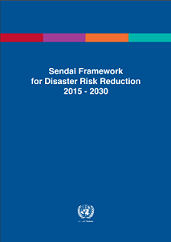Background
The project “Addressing technological/industrial accident risks in national strategies and DRR plans” is being implemented in Kyrgyzstan and Tajikistan in August 2022 – January 2023 under the auspices of the UNECE Convention on the Transboundary Effects of Industrial Accidents (Industrial Accidents Convention) in partnership with the United Nations Office for Disaster Risk Reduction (UNDRR).
The Project is being implemented as a part of the Central Asia Initiative funded by the European Union and implemented during the period 2019-2023 by UNDRR, in cooperation with partner organizations. The initiative aims to strengthen disaster and climate resilience in the sub-region by accelerating the implementation of the Sendai Framework. Dedicated components of the initiative aim to support the development or review of national and local strategies for disaster risk reduction, as well as the improvement of overall risk governance based on multi hazard and multi stakeholder approaches. The consideration and inclusion of technological and industrial accident risks, including such risks caused by natural hazards and those of a transboundary nature, is an important objective of the component. To this end, UNECE and UNDRR have joined forces through a partnership agreement to support Kyrgyzstan and Tajikistan in strengthening their multi-hazard, multi-risk approach, advancing existing policies and strengthening governance of multiple hazards and risks. Looking at multiple hazards and risks comprises raising awareness of how natural hazards, including such hazards aggravated by climate change can trigger so-called “Natech” events. Overall, the initiative aims to also strengthen awareness of transboundary considerations and aims to reinforce cooperation among neighbouring and riparian countries in Central Asia. Its overall objective is to strengthen implementation of the Industrial Accidents Convention and the Sendai Framework for Disaster Risk Reduction.
Project Objective
The general objective of the project is to integrate technological/industrial accident risks into DRR plans of Kyrgyzstan and Tajikistan thus advancing existing policy and governance of multi-hazards risks, including in transboundary context, as well as strengthening the implementation of the Sendai Framework for Disaster Risk Reduction and the UNECE Convention on the Transboundary Effects of Industrial Accidents.
Project Beneficiaries
The project beneficiaries are Kyrgyzstan and Tajikistan, namely their competent authorities for the Industrial Accidents Convention and those serving as National Platforms for implementation of the Sendai Framework.
Expected Results
It is expected that the project will result in:
- Improved engagement of and collaboration with Kyrgyzstan’s and Tajikistan’s national authorities
- Increased understanding of country-specific context in terms of industrial accidents and technological DRR
- Technological/industrial accident risks introduced/enhanced in the national DRR plans (or documents replacing them) aiming to benefit overall DRR policy and governance
- Country-specific recommendations developed to facilitate better management of technological/industrial accident risks, including Natech risks, strengthen transboundary considerations and thus contribute to the implementation of the Sendai Framework and the UNECE Industrial Accidents Convention.
Project Activities
- Project inception meeting (online, 26 September)
- Regional Forum – Meeting of the Heads of Emergency Services of Central Asia (Dushanbe, 4-6 October 2022)
- Consultations with national stakeholders (October-November 2022)
- Detailed review of the
- Concept of Comprehensive Protection of the Population and Territory of the Kyrgyz Republic in emergency situations for 2018 – 2030
- National Disaster Risk Reduction Strategy of the Republic of Tajikistan for 2019-2030 and development of country-specific context analysis (November-December 2022)
- Detailed review of the
- Action Plan for implementation of the Concept of Comprehensive Emergency Protection of the Population and Territory of the Kyrgyz Republic for 2018-2030 (stage II - 2023-2026)
- Midterm Government Program (National Action Plan) of Tajikistan to protect the population and environment from emergencies for 2022-2024 and development of country-specific recommendations on the integration of technological/industrial accident risks, including Natech, and transboundary considerations, into the above documents and related policies (December 2022 – January 2023).
- Subregional working lunch dedicated to the “Progress of the Central Asian countries in integrating the risks of technological disasters into DRR policies and in the implementation of the UNECE Industrial Accidents Convention” (Geneva, 1 December 2022)
- Presentation of project results at the final meeting of the Central Asia Initiative (Almaty, 15 February 2023)
Linkages to the 2030 Agenda for Sustainable Development and Sendai Framework for Disaster Risk Reduction for 2015-2030
The project seeks to support beneficiary countries in achieving relevant Sustainable Development Goals (SDGs). Notably, it will help in the implementation of the SDGs 3, 6, 9, 11, 12 and 13, including the below targets:

Target 3.9 By 2030, substantially reduce the number of deaths and illnesses from hazardous chemicals

Target 6.3 By 2030, improve water quality by reducing pollution, eliminating dumping and minimizing release of hazardous chemicals and materials, halving the proportion of untreated wastewater and substantially increasing recycling and safe reuse globally

Target 9.4. By 2030, upgrade infrastructure and retrofit industries to make them sustainable, with increased resource-use efficiency and greater adoption of clean and environmentally sound technologies and industrial processes, with all countries taking action in accordance with their respective capabilities

Target 11.b. By 2020, substantially increase the number of cities and human settlements adopting and implementing integrated policies and plans towards inclusion, resource efficiency, mitigation and adaptation to climate change, resilience to disasters, and develop and implement, in line with the Sendai Framework for Disaster Risk Reduction 2015-2030, holistic disaster risk management at all levels

Target 12.4 By 2020, achieve the environmentally sound management of chemicals... throughout their life cycle, in accordance with agreed international frameworks...

Target 13.1 Strengthen resilience and adaptive capacity to climate-related hazards and natural disasters in all countries

Furthermore, through integration of technological/industrial risks into national DRR plans, the Project will contribute to achieving the objectives and four priorities of the Sendai Framework for Disaster Risk Reduction 2015-2030, notably:
Priority 1: understanding disaster risk,
Priority 2: strengthening disaster risk governance to manage disaster risk,
Priority 3: investing in disaster risk reduction for resilience, and
Priority 4: enhancing disaster preparedness for effective response.